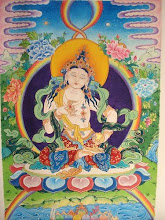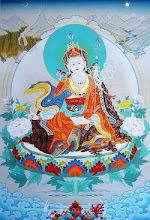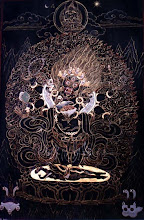The Kyoto Vipassana Center was a veritable hotel.
There was soap in the bathroom, detergent for washing clothes (by hand in a bucket), a spinner to save you the effort of hand wringing wet clothes, screens on all the windows, hot water on demand, clean futons, immaculate wood floors, a wide assortment of condiments (such as pickles, teas and sweeteners), insect repellent, salve for bug bites, a large container of medicines in the kitchen, complimentary earplugs in case you were bunking with a snorer, and fans in all the rooms. The only thing not included were sheets, which oddly enough were one of the few provisions at Bodhgaya and Sarnath, the two India centers I visited in 2007 and 2008. There we had nothing more than a bed, cold water, buckets, and mosquitoes (even in December).
Fortunately, few of the latter were buzzing about Kyoto, even in the midst of summer. We did, though, seem to have more than a fair share of spiders and cockroaches, neither of which were a particular bother, except for the cobwebs that occasionally came in contact with my face. Pleh, pleh . . .
The Kyoto center was christened Dhamma Bhanu (Dhamma Light) by Goenkaji himself back around 1989 when the master paid a visit and taught a course or two himself. Today you'd hardly guess that the facilities are 20 years old. It seems a good amount of love and attention has been lavished on their maintenance.
 Stairs at left from the Dhamma Hall / Residential Building.
Stairs at left from the Dhamma Hall / Residential Building.Building at right toilet/shower block, building left dining hall and kitchen.
Like most Japanese buildings or compounds, those of Dhamma Bhanu are rather compact. The residential quarters and Dhamma hall are in the same building. My room was only 5-6 meters from where I sat each day for meditation. Even those housed furthest from the hall are no more than 20-30 meters away. Once you leave the residential building, its only a dozen paces to the bath/toilet block or to the dining hall.
 The Dhamma Hall is in the center on the second floor;
The Dhamma Hall is in the center on the second floor; left wing is female residence, right wing male.
The garden was available for walking to female students.
 To the right of the above photo was this patch of grass and clover,
To the right of the above photo was this patch of grass and clover, used for overflow and as walking space for male students.
The center sits in a valley in northern Kyoto prefecture, a quiet pocket of Japan through which passes one narrow road used each day by perhaps a dozen or so drivers. When you're sitting you might also notice a small plane passing overhead a couple of times a day. Otherwise there are few audible intrusions of the surrounding society – no school bells, no trucks blaring advertisements, no construction, no kids playing ball. Just the relaxing chirping of crickets, cicadas, and birds, as well as the gurgling of a small stream running around the perimeter of the center's property, bounded by low mountains (or high hills), a lush green in the midst of the summer season.
At this time of year typical daytime temperatures are uncomfortably warm. A center volunteer noted that the heat often makes meditation uncomfortable. We were quite fortunate, though, to have rain every day of the ten our group was in residence. The sun came out for a couple of hours on two or three days, but for the remainder it was overcast, windy, and wet. I didn't hear anyone using electric fans in the evening. It was a bit too chilly for that.
I understand installation of air conditioning in the Dhamma Hall is under discussion. Perhaps it will be added soon to make life more bearable for those city seekers brave enough to sit quietly for ten days with few of the comforts to which they are accustomed. If you happen to have difficulty with mobility, though, you will not be able to meditate at the Kyoto center. The Dhamma Hall is located on the second floor, up a flight of 16 steep steps, and if you also happen to be male you'll have to climb another set of steps to get to your meals. New students can expect to share a room with anywhere from three to six others, with little more than a futon-size private space. Old students may also have to share living quarters if they attend during one of the center's peak periods (which coincide with the Japanese vacation calendar – New Year's, Golden Week, and Obon).
As one might expect for a center in Japan staffed by Japanese volunteers, the food was typical Japanese fare. Mid-day meals included oden, pasta with tomato-based vegetable sauce, udon, a one-pot dish of mixed veggies boiled in a light soy sauce, chilled tofu with green veggies, and on the last day, Japanese curry. Whatever was left over from lunch was recycled the next morning, along with fresh bread, butter, jam, and copious amounts of fruit, which in summer included bananas, oranges, grapefruits, apples, and plums. The evening meal for new students was fruit, for old students tea. Altogether the food was healthy and the amount adequate, but taste and presentation hardly remarkable.
One thing I greatly appreciated at the Kyoto center (that I did not find at either of the Indian centers I visited) was the management's willingness to share financial information. On the last day of the course when silence is lifted and donations accepted, a number of placards were erected in front of the dining hall with information on center activities and volunteer opportunities. Included in this presentation was a chart of the center's income and expenses. If you were perhaps wondering about the size of an appropriate donation, you could find that the average daily expense per student is just over 2000yen.
This may seem high in comparison to India, but where in Japan can you get two meals a day, a clean bed, and all the other amenities – plus absolute silence and the chance to meditate? Just make sure you bring cash. Credit card donations are not accepted.
Dhamma Bhanu is a fine facility for sitting Vipassana. I'll be leaving soon to take a job in the Middle East, but should I ever be back this way, and have the opportunity, I would be very pleased to sit another 10-day course in Kyoto.
Links:
#

































actually they also put information about what is needed to be done and what is the cost of it in dhamma giri. that's what U Ba Khin used to do in his center. but not the whole accounts. Maybe they do this in Kyoto to prove people there is no governmental organization behind the center :) but maybe it's not very good for the meditators to know what is the exact average expense. Because then they start thinking their donation in a different way.
ReplyDeleteSo I think now you will be able to sit a satipatthana course. It's really interesting. Then the instructions for meditation come directly from the buddha.
I miss Dhamma Bhanu so much...Thanks for your post. :)
ReplyDeleteBeautiful Collections of Thangkas. And very useful blog. Thanks for sharing
ReplyDeleteBest wishes
Dolma
Hi Thangkas, thanks for the sharing above. Do you know whether the course is taught in Japanese or english is also provided?
ReplyDeleteIt was taught in both when I was there three years ago. This summer at a US center I noticed the teachers were able to accommodate any language through the use of mp3 players and headphones. Perhaps they're doing the same in Japan. Write to them and find out.
ReplyDelete